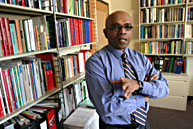Modelling the future
Civil Engineering professor Patrick Selvadurai has a window into the future, not through gazing into a crystal ball, but by applying mathematical modelling to everyday scenarios. With such models, Selvadurai investigates a wide range of engineering problems, from the disposal of heat-emitting nuclear waste to pipeline construction in frost-susceptible soils.
Mathematical model development is no simple task. Engineers and scientists develop these models from laboratory data and from the innovative use of known physical relationships. Computer simulations are indispensable in the process -- especially if long-term effects are under consideration. A major challenge, notes Selvadurai, is the need to make models behave to scale -- in other words, they should be equally applicable in the laboratory and in the field.

Civil engineering professor Patrick Selvadurai
Owen Egan
"Mathematical modelling realizes its full potential when you have to make long-range predictions," says Selvadurai. Many suggestions for nuclear waste storage propose that it be contained in underground repositories for thousands of years. "The main challenge with deep geological disposal of nuclear waste is the impact it may have on the groundwater should there be a leak into the surrounding ground or geosphere," explains Selvadurai. The situation is made more complex as the heat emitted by stored nuclear waste could alter the normal groundwater flow patterns near the repository, especially over a long period of time.
Using mathematical models, Selvadurai and his research group have shown how thermal effects can influence groundwater movement over time scales of the order of 10,000 years. "Realistically, when dealing with decaying radioactive materials this is the time frame you must focus on," he says. With Selvadurai's models, regulatory agencies, such as the Canadian Nuclear Safety Commission, can configure their guidelines to ensure enhanced safety at any future repository.
Mathematical models can be applied to many different engineering puzzles. In another project, Selvadurai has examined how a buried pipeline might behave in diverse soils. When liquefied natural gas is transported by pipeline, it is usually chilled to around -5°C. However, the cooling leads to a side effect -- the soil around the pipeline freezes.
"If the freezing occurs uniformly along the pipeline, it is not a great problem," says Selvadurai. "But along a pipeline route we encounter many soil conditions. The freezing and the resulting frost heave are uneven, which places distress on the pipeline." A straight pipeline may begin to snake back and forth due to this uneven frost heave. Selvadurai has been able to develop models that show the frozen earth's impact on pipelines, which provide information for regulatory agencies interested in safer pipeline designs. To do so, he had to consider heat conduction and moisture movement in the ground, the freezing process and the mechanical behaviour of both frozen and unfrozen soils.
Although used extensively in engineering, mathematical modelling has limitations. "A model is only our approximate interpretation of what is happening in a particular situation," says Selvadurai. Models isolate only the important components of a phenomenon; this helps researchers understand what can occur, but models rarely give perfect predictions.
Selvadurai has received many accolades, including the Alexander von Humboldt Senior Researcher and Killam Awards. Most recently, in 2003, he was honoured with the Max Planck Research Award, a first among all McGill faculty and all Canadian engineers. The award, along with his recent appointment to the William Scott Chair in Civil Engineering, will allow Selvadurai to explore new problems, such as the effects of high-frequency underwater waves on marine life.
"Even if you have positive results, which are corroborated by experiments, you can always refine your models -- that is a good thing because it means one never runs out of things to explore," he says.
McGill's SPARK program (Students Promoting Awareness of Research Knowledge) is funded by NSERC and run by the Faculty of Education, VP Research Office and the University Relations Office. See www.spark.mcgill.ca for more information and articles.
